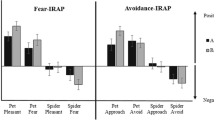Abstract
The purpose of this study was to examine confirmation bias in children without explicitly inducing fear. Eighty non-clinical children (7–13 years) were shown pictures of a neutral animal (quokka) and two dangerous-looking animals (aye aye and possum). For each animal, levels of perceived fear, threat and request for additional threatening or non-threatening information were obtained. A behavioral approach test (BAT) was included as behavioral measure of fear. The results indicated that the aye aye and possum were rated as more threatening and fearful than the quokka. For the aye aye and possum higher fear levels coincided with search for more threatening than non-threatening information. This pattern was absent in non-fearful children and for the non-threatening quokka. During the BAT the quokka was more often approached first compared to the aye aye and possum. Our findings suggest that confirmation bias in children can be observed without using verbal fear induction.


Similar content being viewed by others
Notes
Note that similar results were obtained in case gender was not entered as a factor in the analyses.
References
Beck AT, Clark DA (1997) An information processing model of anxiety: automatic and strategic processes. Behav Res Ther 35:49–58
Eysenck MW, Derakshan N, Santos R, Calvo MG (2007) Anxiety and cognitive performance: attentional control theory. Emotion 7:336–353
Ouimet AJ, Gawronski B, Dozois DJA (2009) Cognitive vulnerability to anxiety: a review and an integrative model. Clin Psychol Rev 29:459–470
De Jong PJ, Mayer B, Van Den Hout M (1997) Conditional reasoning and phobic fear: evidence for a fear-confirming reasoning pattern. Behav Res Ther 35:507–516
Smeets G, de Jong PJ, Mayer B (2000) If you suffer from a headache, then you have a brain tumour: domain-specific reasoning ˜bias” and hypochondriasis. Behav Res Ther 38:763–776
Muris P, Field AP (2010) The role of verbal threat information in the development of childhood fear. “Beware the jabberwock!”. Clin Child Fam Psychol Rev 13:129–150
Muris P, Field A (2013) Information processing biases. The Wiley-Blackwell handbook of the treatment of childhood and adolescent anxiety, John Wiley & Sons, Ltd., pp 141–156
Kessler R, Ruscio A, Shear K, Wittchen HU (2010) Epidemiology of anxiety disorders. Behavioral neurobiology of anxiety and its treatment, current topics in behavioral neurosciences. Springer, Berlin Heidelberg, pp 21–35
Merikangas KR, Nakamura EF, Kessler RC (2009) Epidemiology of mental disorders in children and adolescents. Dialogues Clin Neurosci 11:7–20
Waters AM, Lipp OV, Spence SH (2004) Attentional bias toward fear-related stimuli: an investigation with nonselected children and adults and children with anxiety disorders. J Exp Child Psychol 89:320–337
Muris P et al (2000) Anxiety and threat perception abnormalities in normal children. J Psychopathol Behav Assess 22:183–199
Hadwin J, Frost S, French CC, Richards A (1997) Cognitive processing and trait anxiety in typically developing children: evidence for an interpretation bias. J Abnorm Psychol 106:486–490
Muris P et al (2009) Effects of verbal information on fear-related reasoning biases in children. Behav Res Ther 47:206–214
Remmerswaal D, Muris P, Mayer B, Smeets G (2010) “Will a cuscus bite you, if he shows his teeth?” inducing a fear-related confirmation bias in children by providing verbal threat information to their mothers. J Anxiety Disord 24:540–546
Muris P, Huijding J, Mayer B, van As W, van Alem S (2011) Reduction of verbally learned fear in children: a comparison between positive information, imagery, and a control condition. J Behav Ther Exp Psychiatry 42:139–144
Ollendick TH (1983) Reliability and validity of the revised fear survey schedule for children (FSSC-R). Behav Res Ther 21:685–692
Huijding J, Muris P, Lester KJ, Field AP, Joosse G (2011) Training children to approach or avoid novel animals: effects on self-reported attitudes and fear beliefs and information-seeking behaviors. Behav Res Ther 49:606–613
Kivlighan DM, Lo Coco G, Gullo S (2012) Attachment anxiety and avoidance and perceptions of group climate: an actor-partner interdependence analysis. J Couns Psychol 59:518–527
Liberman LC, Lipp OV, Spence SH, March S (2006) Evidence for retarded extinction of aversive learning in anxious children. Behav Res Ther 44:1491–1502
Jovanovic T et al (2014) Development of fear acquisition and extinction in children: effects of age and anxiety. Neurobiol Learn Mem 113:135–142
Remmerswaal D, Huijding J, Bouwmeester S, Brouwer M, Muris P (2014) Cognitive bias in action: evidence for a reciprocal relation between confirmation bias and fear in children. J Behav Ther Exp Psychiatry 45:26–32
Öhman A, Mineka S (2001) Fears, phobias, and preparedness: toward an evolved module of fear and fear learning. Psychol Rev 108:483–522
Remmerswaal D, Muris P, Huijding J (2014) Parent-offspring transmission of a fear-related cognitive bias: an experimental study. J Clin Child Adolesc Psychol (in press)
Acknowledgments
The authors would like to thank Samantha van Hattum, Boukje Nass and Lisanne Peters for their help during data-acquisition. We would also like to thank the schools, parents and children for their contribution.
Conflict of interest
The authors declare that they have no conflict of interest.
Author information
Authors and Affiliations
Corresponding author
Rights and permissions
About this article
Cite this article
Dibbets, P., Fliek, L. & Meesters, C. Fear-Related Confirmation Bias in Children: A Comparison Between Neutral- and Dangerous-Looking Animals. Child Psychiatry Hum Dev 46, 418–425 (2015). https://doi.org/10.1007/s10578-014-0481-3
Published:
Issue Date:
DOI: https://doi.org/10.1007/s10578-014-0481-3




